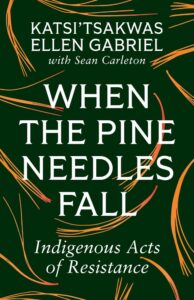Book review: When the Pine Needles Fall: Indigenous Acts of Resistance
 Reviewed by Caroline MacKenzie
Reviewed by Caroline MacKenzie
When the Pine Needles Fall: Indigenous Acts of Resistance by Katsi’tsakwas Ellen Gabriel with Sean Carleton is about Katsi’tsakwas’ experience at the siege of Kanehsata:ke and Kahnawa:ke during the summer of 1990. This was commonly referred to as the Oka Crisis. Gabriel served as the Kanien’keha:ka (Mohawk) spokesperson during this time and in her book discusses the issues surrounding it.
This book shows the siege from Indigenous perspectives framed by Canada’s historical systemic treatment of Indigenous peoples and Colonization. The Doctrine of Discovery and its use by governments to justify their treatment of Indigenous people and claims of superiority is also discussed. This is very different from the media’s portrayal and the governments’ false claim that there is no history of Colonialism in Canada. This serves to educate the reader about these issues. The validity of this perspective is strengthened by the fact that Katsi’tsakwas was there.
This book also teaches about Kanien’keha:ka culture. The reader learns about the cultural significance of the land at the heart of the siege and the roles of men and women, which further enhances the readers understanding of the crisis and Mohawk culture.
To further the educational impact of this book, a glossary of Mohawk words and appendices is provided. This gives the reader resources to learn more about the siege, related issues, and Kanie”keha:ka culture.
The tone of this book switches between anger, frustration, and resilience. Put into context, the reader understands where these emotions are coming from. Katsi’sakwas also issues a heartfelt invitation to the reader to become an Indigenous ally. This ensures the reader does not dismiss what they’re reading and see how they can move change forward.
This book is written as a conversation, with Sean Carleton asking questions and Katsi’tsakwas responding, honouring the oral traditions of Indigenous peoples. This also mitigates the tone as it is like two friends talking about serious and important issues.
The language Katsi’tsakwas uses and how she expresses herself serves to dispel the negative portrayal of Indigenous people in the media. She is articulate and uses facts to backup what she is saying. The reader feels invited to be part of the solution.
The fear felt by Indigenous people daily—fear of the police, the military and the government—is highlighted by Katsi’tsakwas. The police and the military shot at the protesters with live ammunition when the women (the Land Defenders in Mohawk culture) stepped back from the barricades to discuss their next course of action. Again, this showed the government’s lack of willingness to engage with Indigenous people to resolve issues.
Katsi’sakwas also uses this book to discuss reconciliation and decolonization and what is needed for this to occur in any meaningful way. This highlights the willingness of Indigenous people to work with governments in a culturally appropriate way, the opposite of the portrayal in the media.
The photographs included in the book strengthen its impact. Events become much more real to the reader, allowing a deeper understanding of the siege. The author has included pictures of Indigenous art are also included showcasing the beauty of Indigenous art.
This book is a must-read for anyone wanting to learn about this incident, the Doctrine of Discovery, Colonialism and historical systemic treatment of Indigenous peoples, and how they can be part of reconciliation.
Katsi’tsakwas Ellen Gabriel with Sean Carleton, When the Pine Needles Fall: Indigenous Acts of Resistance. Between the Lines: Toronto, 2024.
ISBN: 97817771136501


